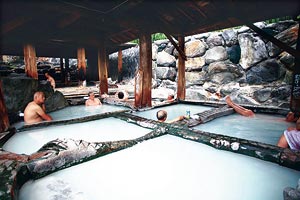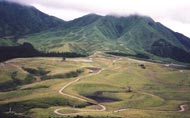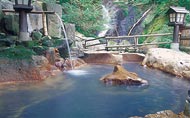25.Jigoku and Tarutama Hot Springs Geosite

Geothermal area and hot springs, explosion crater
As is common in volcanic zones, hot springs are found throughout the Aso region. The characteristics of the water vary greatly from one onsen to the next. The region as a whole is referred to as Aso Spa, and draws many tourists.
Although hot springs in volcanic areas typically contain hot water and gasses originating in magma, Aso's hot springs are fed by groundwater that filters through the earth and are notable for their low percentage of magmatic substances.
Minami-Aso's Jigoku ("hell") and Tarutama Onsens are strongly influenced by Aso Volcano, with highly acidic, sulfurous water. They are known prefecture-wide for their high quality, and since the Edo era have drawn guests seeking their healing properties. During the Meiji and Showa eras writers and artist flocked to the spas as well. Among them was poet Ujo Noguchi, one of whose verses extols the beauty of fall leaves viewed from Tarutama. A group of five young poets including Tekkan Yosano, Hakushu Kitahara, and Isamu Yoshii also visited the spas and wrote about them in the travelogue Gosoku no Kutsu, or "Five Pairs of Shoes."
Among this region's other notable geosites is the explosion crater Ikenokubo. Shaped like a wide, flat plate measuring 600 m across, the crater features a water-filled tuff ring formed at least 10,000 years ago by a volcanic explosion.

Ikenokubo
This wide, plate-shaped crater in the north of Mt. Yomine measures 600 m across. Two smaller craters sit inside of it, the westernmost of which is a water-filled ring depression called the Ikenokubo Tuff Ring that is at least 10,000 years old.

Jigoku and Tarutama Hot Springs
Approaching Jigoku and Tarutama Onsens from afar, one first sees the ribbons of steam curling into the air above them. Located on the southwestern side of the central cone group at an elevation of 700 m, both have a long history of use: Jigoku, which sits inside Mt. Yomine's explosion crater, has thrived as a health spa since the Edo period, and locals have bathed at Tarutama since at least the late 1500s.
